Blog
Cleaning and Dressing a Wound on the Foot
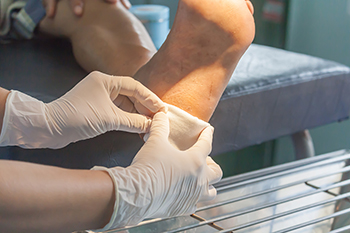
The risk of infection from a wound on the foot may be reduced when it is cleaned properly. The wound can be cleaned by rinsing it under running water for several minutes and covering it with a gauze pad. This is generally followed by applying a protective covering that is adequate to stop existing bleeding. If the wound is severe, pressure may be applied temporarily which may help to control bleeding. Diabetic patients may develop wounds on the feet more frequently than other patients. This may be a result of the inability to feel cuts, bruises, or wounds on the feet because neuropathy may be present. Wounds on the feet can be a serious matter, and it is strongly advised that you are under the care of a podiatrist who can properly evaluate why the wound and treat it accordingly.
Wound care is an important part in dealing with diabetes. If you have diabetes and a foot wound or would like more information about wound care for diabetics, consult with Elliot T. Udell, DPM from New York. Our doctor will assess your condition and provide you with quality foot and ankle treatment.
What Is Wound Care?
Wound care is the practice of taking proper care of a wound. This can range from the smallest to the largest of wounds. While everyone can benefit from proper wound care, it is much more important for diabetics. Diabetics often suffer from poor blood circulation which causes wounds to heal much slower than they would in a non-diabetic.
What Is the Importance of Wound Care?
While it may not seem apparent with small ulcers on the foot, for diabetics, any size ulcer can become infected. Diabetics often also suffer from neuropathy, or nerve loss. This means they might not even feel when they have an ulcer on their foot. If the wound becomes severely infected, amputation may be necessary. Therefore, it is of the upmost importance to properly care for any and all foot wounds.
How to Care for Wounds
The best way to care for foot wounds is to prevent them. For diabetics, this means daily inspections of the feet for any signs of abnormalities or ulcers. It is also recommended to see a podiatrist several times a year for a foot inspection. If you do have an ulcer, run the wound under water to clear dirt from the wound; then apply antibiotic ointment to the wound and cover with a bandage. Bandages should be changed daily and keeping pressure off the wound is smart. It is advised to see a podiatrist, who can keep an eye on it.
If you have any questions, please feel free to contact our office located in Hicksville, NY . We offer the newest diagnostic and treatment technologies for all your foot care needs.
What Is Maffucci Syndrome?
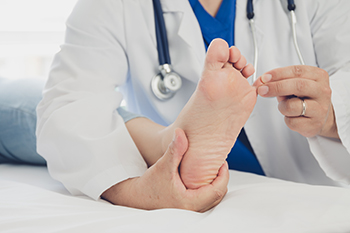
Podiatrists are familiar with the fact that there are a number of rare foot conditions that can impact the health of someone’s feet. Maffucci syndrome is one such rare foot condition. This condition typically impacts the hands and the feet. It is so rare that less than 200 cases have been reported since its discovery in 1881. If an individual has Maffucci syndrome, they may experience the development of benign growths on the bones of the feet. These growths are especially located at the end of the bones. This condition is potentially serious because although the growths are initially benign, it is possible that they may become malignant (meaning cancerous). Interestingly, Maffucci syndrome is not an inherited condition, and those living with the syndrome can be smaller in stature. If you want to learn more about Maffucci syndrome or other rare foot conditions, contact a podiatrist today.
Some foot conditions may require additional professional care. If you have any concerns, contact Elliot T. Udell, DPM of New York. Our doctor can provide the care you need to keep you pain-free and on your feet.
Rare Foot Conditions
The majority of foot conditions are common and can be treated by a podiatrist. Standard diagnostic procedures are generally used to identify specific conditions and treatment can be rendered. A podiatrist also treats rare foot conditions which can be difficult to diagnose and may need extra attention and care.
There are many rare foot conditions that can affect children. Some of these can include:
- Freiberg’s disease
- Kohler’s disease
- Maffucci syndrome
Freiberg’s disease - This can be seen as a deterioration and flattening of a metatarsal bone that exists in the ball of the foot. It typically affects pre-teen and teenage girls, but can affect anyone at any age. Symptoms that can accompany this can be swelling, stiffness, and the patient may limp.
Kohler’s disease - This often targets the bone in the arch of the foot and affects younger boys. It can lead to an interruption of the blood supply which ultimately can lead to bone deterioration. The patient may limp or experience tenderness, swelling, and redness.
Maffucci syndrome - This affects the long bones in a child’s foot leading to the development of abnormal bone lesions. They are benign growths and typically develop in early childhood and the bones may be susceptible to breaking.
A podiatrist can properly diagnose and treat all types of rare foot conditions. If your child is affected by any of these symptoms or conditions, please don’t hesitate to call our office so the correct treatment method can begin.
If you have any questions please feel free to contact our office located in Hicksville, NY . We offer the newest diagnostic tools and technology to treat your foot and ankle needs.
Why Live with Pain and Numbness in Your Feet?
Two Categories of Orthotics
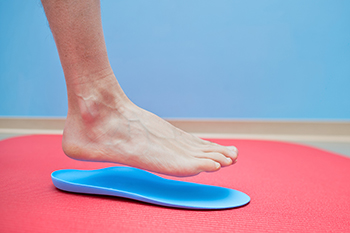
Orthotics are insoles that fit into the shoe. Custom-made orthotics are specifically designed to the individual patient and foot condition and can be a successful method in reducing or eliminating foot pain. Wearing orthotics may help to restore ankle function, in addition to correcting foot deformities, such as flat feet. Many patients who have bunions, hammertoes, arthritis, or diabetes may benefit from wearing orthotics as part of their treatment plan. There are two types of orthotics, rigid and accommodative. The latter type is flexible and cushioned, while plastic materials are used to construct rigid orthotics. The process of having custom-made orthotics begins by having a mold made of the patient’s feet, while considering their footwear needs. If you have a foot condition that may be helped by wearing orthotics, please contact a podiatrist who can determine if this is the best decision for you.
If you are having discomfort in your feet and would like to try orthotics, contact Elliot T. Udell, DPM from New York. Our doctor can provide the care you need to keep you pain-free and on your feet.
What Are Orthotics?
Orthotics are inserts you can place into your shoes to help with a variety of foot problems such as flat feet or foot pain. Orthotics provide relief and comfort for minor foot and heel pain but can’t correct serious biomechanical problems in your feet.
Over-the-Counter Inserts
Orthotics come in a wide variety of over-the-counter inserts that are used to treat foot pain, heel pain, and minor problems. For example, arch supports can be inserted into your shoes to help correct overarched or flat feet, while gel insoles are often used because they provide comfort and relief from foot and heel pain by alleviating pressure.
Prescription Orthotics
If over-the-counter inserts don’t work for you or if you have a more severe foot concern, it is possible to have your podiatrist prescribe custom orthotics. These high-quality inserts are designed to treat problems such as abnormal motion, plantar fasciitis, and severe forms of heel pain. They can even be used to help patients suffering from diabetes by treating foot ulcers and painful calluses and are usually molded to your feet individually, which allows them to provide full support and comfort.
If you are experiencing minor to severe foot or heel pain, it’s recommended to speak with your podiatrist about the possibilities of using orthotics. A podiatrist can determine which type of orthotic is right for you and allow you to take the first steps towards being pain-free.
If you have any questions please contact our office located in Hicksville, NY . We offer the newest diagnostic and treatment technologies for all your foot and ankle needs.
Duration of Corns on the Feet
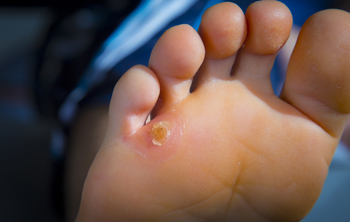
Corns can develop on one’s feet as a protective mechanism against friction or pressure. Corns typically have a dense core at the center, and they come in different types (hard corns and soft corns). Many individuals living with corns on the feet will not notice any symptoms associated with their condition. Others, however, might experience pain or irritation when walking. Patients with corns on the feet often wonder how long this condition typically lasts. Although it can vary from case to case, corns could be a long-term problem if nothing is done to address the cause. For instance, if you continue to wear ill-fitting footwear that rubs against your skin, this can exacerbate the emergence of corns. Additionally, if you can not correct problems in your gait that subject specific parts of your feet to friction or pressure, this can increase the risk of developing corns. If you have corns, it is a good idea to contact a podiatrist today for treatment.
If you have any concerns regarding your feet and ankles, contact Elliot T. Udell, DPM of New York. Our doctor will treat your foot and ankle needs.
Corns: What Are They? and How Do You Get Rid of Them?
Corns can be described as areas of the skin that have thickened to the point of becoming painful or irritating. They are often layers and layers of the skin that have become dry and rough, and are normally smaller than calluses.
Ways to Prevent Corns
There are many ways to get rid of painful corns such as wearing:
- Well-fitting socks
- Comfortable shoes that are not tight around your foot
- Shoes that offer support
Treating Corns
Treatment of corns involves removing the dead skin that has built up in the specific area of the foot. Consult with Our doctor to determine the best treatment option for your case of corns.
If you have any questions please feel free to contact our office located in Hicksville, NY . We offer the newest diagnostic and treatment technologies for all your foot and ankle needs.
Facts About Gout
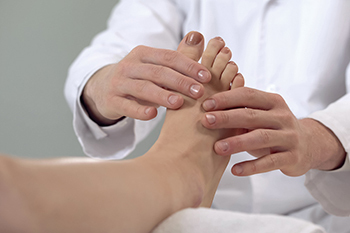
Gout is a form of arthritis, or inflammation, caused by a buildup of uric acid in the system. The main symptoms are redness, swelling, pain, and tenderness in a joint. The joint at the base of the big toe is commonly affected by gout. The range of motion in the joint decreases and even the slightest touch can cause extreme pain. Certain medications, dietary choices, drinking alcohol and sugary beverages, age, and genetics can play a part in the development of gout. Eating foods rich in purines, such as red meat and seafood, can increase the risk. People with diabetes, thyroid problems, and high blood pressure are also at a higher risk of gout. Men over 40 and menopausal women are more at risk as well. Medication and lifestyle changes are large factors in holding off gout. Corticosteroids and non-steroidal anti-inflammatory medications may be prescribed by a podiatrist to help reduce the pain and inflammation. In addition, certain medications can help to reduce uric acid production and eliminate it from the body. Please make an appointment with a podiatrist for additional treatment options for gout.
Gout is a painful condition that can be treated. If you are seeking treatment, contact Elliot T. Udell, DPM from New York. Our doctor will treat your foot and ankle needs.
What Is Gout?
Gout is a form of arthritis that is characterized by sudden, severe attacks of pain, redness, and tenderness in the joints. The condition usually affects the joint at the base of the big toe. A gout attack can occur at any random time, such as the middle of the night while you are asleep.
Symptoms
- Intense Joint Pain - Usually around the large joint of your big toe, and it most severe within the first four to twelve hours
- Lingering Discomfort - Joint discomfort may last from a few days to a few weeks
- Inflammation and Redness -Affected joints may become swollen, tender, warm and red
- Limited Range of Motion - May experience a decrease in joint mobility
Risk Factors
- Genetics - If family members have gout, you’re more likely to have it
- Medications - Diuretic medications can raise uric acid levels
- Gender/Age - Gout is more common in men until the age of 60. It is believed that estrogen protects women until that point
- Diet - Eating red meat and shellfish increases your risk
- Alcohol - Having more than two alcoholic drinks per day increases your risk
- Obesity - Obese people are at a higher risk for gout
Prior to visiting your podiatrist to receive treatment for gout, there are a few things you should do beforehand. If you have gout you should write down your symptoms--including when they started and how often you experience them, important medical information you may have, and any questions you may have. Writing down these three things will help your podiatrist in assessing your specific situation so that he or she may provide the best route of treatment for you.
If you have any questions, please feel free to contact our office located in Hicksville, NY . We offer the newest diagnostic and treatment technologies for all your foot care needs.
Why a Bunion Develops and What to Do About It
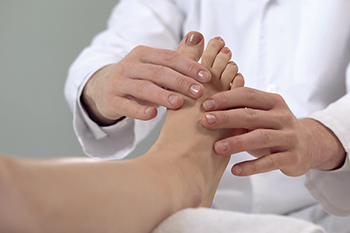
A bunion, known as hallux valgus, is a bony bump that occurs on the joint of the big toe. It forms from bones in the top part of the foot moving out of place, which causes the tip of the big toe to be pulled toward the smaller toes. It also forces the joint in the big toe to be stuck. Women and elderly people are most apt to suffer with bunions. These rarely occur in children, but sometimes babies are born with bunions, or they form in later childhood. The skin above the bunion might be sore and red. Bunions can form by wearing narrow or tight shoes, from one’s foot shape, way of walking, a medical condition, or a foot deformity. Calluses might develop where the big and 2nd toe touch, or on the ball of the foot. Bunion pads, well-fitted shoes, or toe spacers might help with bunion discomfort, and if not, bunion surgery (a bunionectomy) might be an option. Untreated bunions may get worse over time, and it might be difficult to walk or wear regular shoes without pain. If you have a bunion and it hurts, contact a podiatrist for the best treatment option for you.
If you are suffering from bunions, contact Elliot T. Udell, DPM of New York. Our doctor can provide the care you need to keep you pain-free and on your feet.
What Is a Bunion?
A bunion is formed of swollen tissue or an enlargement of boney growth, usually located at the base joint of the toe that connects to the foot. The swelling occurs due to the bones in the big toe shifting inward, which impacts the other toes of the foot. This causes the area around the base of the big toe to become inflamed and painful.
Why Do Bunions Form?
Genetics – Susceptibility to bunions are often hereditary
Stress on the feet – Poorly fitted and uncomfortable footwear that places stress on feet, such as heels, can worsen existing bunions
How Are Bunions Diagnosed?
Doctors often perform two tests – blood tests and x-rays – when trying to diagnose bunions, especially in the early stages of development. Blood tests help determine if the foot pain is being caused by something else, such as arthritis, while x-rays provide a clear picture of your bone structure to your doctor.
How Are Bunions Treated?
- Refrain from wearing heels or similar shoes that cause discomfort
- Select wider shoes that can provide more comfort and reduce pain
- Anti-inflammatory and pain management drugs
- Orthotics or foot inserts
- Surgery
If you have any questions, please feel free to contact our office located in Hicksville, NY . We offer the newest diagnostic and treatment technologies for all your foot care needs.
Various Reasons for Ankle Pain
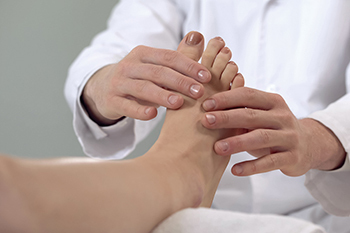
There are several types of ankle disorders that people can experience. These include sprains, fractures, arthritis, and tendonitis. The function of the ankle is to stabilize the body by supporting the surrounding muscles, tendons, and ligaments. Research has shown that it is the most injured part of the body, and when hurt can negatively impact completing daily activities. An ankle sprain or fracture can happen from unexpectedly stepping off of a curb, causing the ligaments to twist beyond their normal range of motion. Additionally, ankle pain may happen from a sudden fall, with increased force on the ankle joint, often causing immediate and severe pain. There are several types of arthritis that can affect the ankle and can cause limited mobility. Osteoarthritis gradually develops, and can happen when the cartilage between the bones wears down. Having stiff joints may be the result of this type of arthritis. An autoimmune inflammatory disease can produce rheumatoid arthritis, and can attack the body’s healthy tissues. If an injury to the ankle has occurred, post-traumatic arthritis may develop from the stress, and joint stiffness may continue for years following the injury. If you have any type of ankle pain, it is strongly advised that you are under the care of a podiatrist who can effectively diagnose and treat ankle disorders.
Ankle pain can be caused by a number of problems and may be potentially serious. If you have ankle pain, consult with Elliot T. Udell, DPM from New York. Our doctor will assess your condition and provide you with quality foot and ankle treatment.
Ankle pain is any condition that causes pain in the ankle. Due to the fact that the ankle consists of tendons, muscles, bones, and ligaments, ankle pain can come from a number of different conditions.
Causes
The most common causes of ankle pain include:
- Types of arthritis (rheumatoid, osteoarthritis, and gout)
- Ankle sprains
- Broken ankles
- Achilles tendinitis
- Achilles tendon rupture
- Stress fractures
- Bursitis
- Tarsal tunnel syndrome
- Plantar fasciitis
Symptoms
Symptoms of ankle injury vary based upon the condition. Pain may include general pain and discomfort, swelling, aching, redness, bruising, burning or stabbing sensations, and/or loss of sensation.
Diagnosis
Due to the wide variety of potential causes of ankle pain, podiatrists will utilize a number of different methods to properly diagnose ankle pain. This can include asking for personal and family medical histories and of any recent injuries. Further diagnosis may include sensation tests, a physical examination, and potentially x-rays or other imaging tests.
Treatment
Just as the range of causes varies widely, so do treatments. Some more common treatments are rest, ice packs, keeping pressure off the foot, orthotics and braces, medication for inflammation and pain, and surgery.
If you have any questions, please feel free to contact our office located in Hicksville, NY . We offer the newest diagnostic and treatment technologies for all your foot care needs.
Do Your Child's Feet Hurt?
Protect Your Hard Working Feet All Day Long
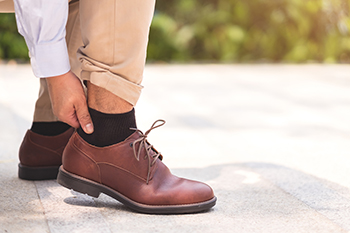 Standing all day while working can lead to pain, swelling, and long-term foot complications. That is why it is vital to use scheduled work breaks to elevate your feet, and take other precautionary measures to mitigate the damages working on your feet can cause to your feet and ankles. The best line of defense starts with proper footwear. Invest in a good pair (or two) of work shoes that provide proper support in the ankle and heels, plenty of cushioning, and stability. Your podiatrist can recommend other specific features to look for, based on the structure of your feet. They can also create custom orthotics to address any specific structural or alignment issues you may have which may cause pain and stress in other areas of your body. There are certain stretches and exercises your podiatrist may also suggest to stretch your feet, calf muscles and Achilles tendon. They may also recommend compression stockings to help stimulate circulation in your feet and reduce swelling. After a long day standing on the job, it is important to help your feet and ankles recover. Pamper your feet by soaking them in a warm bath. Massaging your feet and/or icing them may help to reduce swelling and soothe sore muscles. Contact a podiatrist near you to learn more about protecting your hard working feet on the job.
Standing all day while working can lead to pain, swelling, and long-term foot complications. That is why it is vital to use scheduled work breaks to elevate your feet, and take other precautionary measures to mitigate the damages working on your feet can cause to your feet and ankles. The best line of defense starts with proper footwear. Invest in a good pair (or two) of work shoes that provide proper support in the ankle and heels, plenty of cushioning, and stability. Your podiatrist can recommend other specific features to look for, based on the structure of your feet. They can also create custom orthotics to address any specific structural or alignment issues you may have which may cause pain and stress in other areas of your body. There are certain stretches and exercises your podiatrist may also suggest to stretch your feet, calf muscles and Achilles tendon. They may also recommend compression stockings to help stimulate circulation in your feet and reduce swelling. After a long day standing on the job, it is important to help your feet and ankles recover. Pamper your feet by soaking them in a warm bath. Massaging your feet and/or icing them may help to reduce swelling and soothe sore muscles. Contact a podiatrist near you to learn more about protecting your hard working feet on the job.
While working on the feet, it is important to take the proper care of them. For more information about working on your feet, contact Elliot T. Udell, DPM from New York. Our doctor will treat your foot and ankle needs.
Working on Your Feet
Standing on your feet for long periods of time can cause stress and pain in your feet. Your whole body may experience change in terms of posture, back pain, bunions, callouses and or plantar warts. There are ways to avoid these conditions with proper foot care, smart choices and correct posture.
Positive Changes
Negative heeled shoe – Choosing this shoe type places the heel slightly lower than the ball of the foot. These are great for overall foot health. Find shoes that fit you correctly.
Go barefoot – Our feet were not designed to be enclosed for all hours of the day. Try to periodically expose your feet to air.
Eliminate Pain
Foot Exercises – Performing simple exercises, incorporating yoga and doing stretches are beneficial. This will allow increased blood flow to the area and muscles of the foot.
Achilles tendon – Stretching the foot out flat on the floor will relax the calf muscles and tendon. These exercises can be performed almost anywhere. Make sure you add these exercises to your daily regimen.
With a little bit of this information and knowing more about foot health, you will notice changes. Foot stretches and proper footwear will help with pain and prevent further issues.
If you have any questions please feel free to contact our office located in Hicksville, NY . We offer the newest diagnostic and treatment technologies for all your foot and ankle needs.
More...
When Plantar Warts Spread
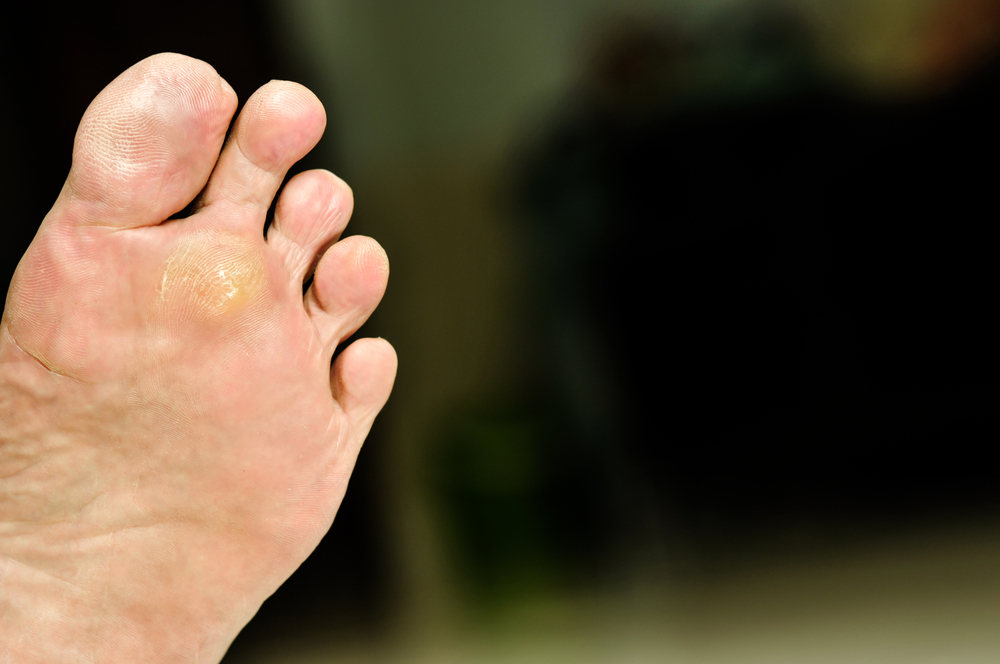
Plantar warts are caused by the human papillomavirus (HPV), and they typically develop on the bottoms of the feet, usually on the balls or heels. These warts can, unfortunately, be particularly painful for some individuals when they walk or put weight on their feet. Since plantar warts are located on the bottoms of the feet, they may essentially grow inward in response to the pressure that is put on the soles of the feet. Plantar warts have a pernicious ability to spread to other parts of the feet and body sometimes very easily. For example, you might unknowingly be spreading your plantar warts if you touch the wart and then immediately touch another part of your body. Additionally, you may be spreading your plantar warts to other people if you share personal self-care tools such as razors or towels. It is not beneficial to your health if your plantar warts begin to spread. If this happens, a medical professional might advise you to use over-the-counter medications to address the problem. If you have plantar warts, you ought to contact a podiatrist especially if you notice that they are beginning to spread. A podiatrist is a foot specialist who can help you take specific steps to identify and address the problem.
Plantar warts can be very uncomfortable. If you need your feet checked, contact Elliot T. Udell, DPM from New York. Our doctor will assist you with all of your foot and ankle needs.
About Plantar Warts
Plantar warts are the result of HPV, or human papillomavirus, getting into open wounds on the feet. They are mostly found on the heels or balls of the feet.
While plantar warts are generally harmless, those experiencing excessive pain or those suffering from diabetes or a compromised immune system require immediate medical care. Plantar warts are easily diagnosed, usually through scraping off a bit of rough skin or by getting a biopsy.
Symptoms
- Lesions on the bottom of your feet, usually rough and grainy
- Hard or thick callused spots
- Wart seeds, which are small clotted blood vessels that look like little black spots
- Pain, discomfort, or tenderness of your feet when walking or standing
Treatment
- Freezing
- Electric tool removal
- Laser Treatment
- Topical Creams (prescription only)
- Over-the-counter medications
To help prevent developing plantar warts, avoid walking barefoot over abrasive surfaces that can cause cuts or wounds for HPV to get into. Avoiding direct contact with other warts, as well as not picking or rubbing existing warts, can help prevent the further spread of plantar warts. However, if you think you have developed plantar warts, speak to your podiatrist. He or she can diagnose the warts on your feet and recommend the appropriate treatment options.
If you have any questions please feel free to contact our office located in Hicksville, NY . We offer the newest diagnostic and treatment technologies for all your foot and ankle needs.
Common Causes of Foot Pain
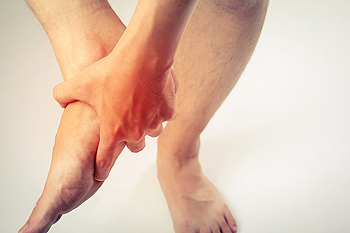
Just about everyone has experienced some kind of foot pain, which can be caused by a number of issues. One sure sign of a foot problem is nerve pain. This includes numbness, tingling, pins and needles, sensitivity to heat or cold, or the inability to detect heat or cold. Another foot complaint is edema, or swelling of the feet, which is the result of a buildup of fluids. The most common causes are injury (ankle sprain), inflammation, medical conditions (gout, high blood pressure), and pregnancy. Burning foot pain is thought to be caused by a nerve problem between the lower back and the foot due to compression, inflammation, or an underlying condition. Other common causes of foot pain are cramps, blisters, rashes, and ingrown toenails. Runners often experience foot and ankle pain, which may be caused by overtraining, previous injury, flat feet, or improper footwear. Sharp pain in or under the big toe may be caused by overuse, hyperextension injuries, tight footwear, or gout. If you are experiencing foot pain that limits your ability to carry out daily activities, please consult a podiatrist for an examination and a diagnosis, so that treatment options can begin.
Foot Pain
Foot pain can be extremely painful and debilitating. If you have a foot pain, consult with Elliot T. Udell, DPM from New York. Our doctor will assess your condition and provide you with quality foot and ankle treatment.
Causes
Foot pain is a very broad condition that could be caused by one or more ailments. The most common include:
- Bunions
- Hammertoes
- Plantar Fasciitis
- Bone Spurs
- Corns
- Tarsal Tunnel Syndrome
- Ingrown Toenails
- Arthritis (such as Gout, Rheumatoid, and Osteoarthritis)
- Flat Feet
- Injury (from stress fractures, broken toe, foot, ankle, Achilles tendon ruptures, and sprains)
- And more
Diagnosis
To figure out the cause of foot pain, podiatrists utilize several different methods. This can range from simple visual inspections and sensation tests to X-rays and MRI scans. Prior medical history, family medical history, and any recent physical traumatic events will all be taken into consideration for a proper diagnosis.
Treatment
Treatment depends upon the cause of the foot pain. Whether it is resting, staying off the foot, or having surgery; podiatrists have a number of treatment options available for foot pain.
If you have any questions, please feel free to contact our office located in Hicksville, NY . We offer the newest diagnostic and treatment technologies for all your foot care needs.
Do I Have Plantar Fasciitis?
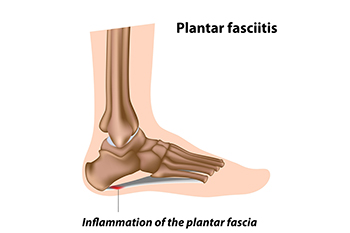
Of all the different potential sources of heel pain, plantar fasciitis is certainly one of the most common. In fact, a wide range of people are affected by this condition. Plantar fasciitis occurs when the plantar fascia becomes inflamed. The plantar fascia is a band of tissue that runs from the heel to the toes. Since plantar fasciitis can be very common, it is important to be aware of the many different typical symptoms. Commonly, those suffering from plantar fasciitis will experience some kind of pain in the heel or the arch of their foot, since the plantar fascia also supports the arch. If you notice that the pain in your heel is most pronounced in the morning when you take your first steps of the day or when you begin to walk after an extended period of rest, this could be an indicator of plantar fasciitis. If you suspect that you may have plantar fasciitis, it is suggested to contact a podiatrist as soon as possible. A podiatrist will then be able to perform a proper diagnosis by examining your feet and inquiring about your amount of regular physical activity.
Plantar fasciitis can be very painful and inconvenient. If you are experiencing heel pain or symptoms of plantar fasciitis, contact Elliot T. Udell, DPM from New York. Our doctor can provide the care you need to keep you pain-free and on your feet.
What Is Plantar Fasciitis?
Plantar fasciitis is the inflammation of the thick band of tissue that runs along the bottom of your foot, known as the plantar fascia, and causes mild to severe heel pain.
What Causes Plantar Fasciitis?
- Excessive running
- Non-supportive shoes
- Overpronation
- Repeated stretching and tearing of the plantar fascia
How Can It Be Treated?
- Conservative measures – anti-inflammatories, ice packs, stretching exercises, physical therapy, orthotic devices
- Shockwave therapy – sound waves are sent to the affected area to facilitate healing and are usually used for chronic cases of plantar fasciitis
- Surgery – usually only used as a last resort when all else fails. The plantar fascia can be surgically detached from the heel
While very treatable, plantar fasciitis is definitely not something that should be ignored. Especially in severe cases, speaking to your doctor right away is highly recommended to avoid complications and severe heel pain. Your podiatrist can work with you to provide the appropriate treatment options tailored to your condition.
If you have any questions please feel free to contact our office located in Hicksville, NY . We offer the newest diagnostic and treatment technologies for all your foot and ankle needs.



